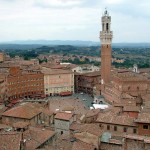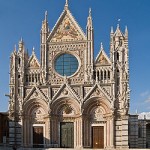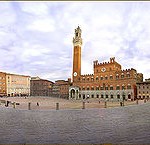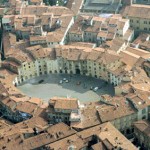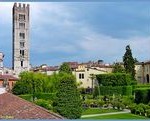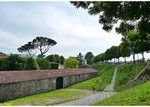
Although Volterra remains a quiet, off-the-beaten-path town… it boasts medieval, winding streets and gorgeous views from its hilltop perch. Volterra’s roots date back to an 8th century B.C. Etruscan settlement; big parts of the defensive wall they built in the 4th century B.C. are still standing, as is the 3rd century B.C. gate into the city! But that’s not all for the ancient side of Volterra. Here, too, are remains of an ancient Roman amphitheatre and bathhouse, as well as the renowned Museo Etrusco Guarnacci, boasting numerous Etruscan finds from the area.
Author: LaLaItalia
The Top Ten Towns of Tuscany – # 4 Siena
Siena is an historic city in Tuscany, Italy. It is the capital of the province of Siena. Unesco has declared the historic centre of Siena a World Heritage Site. It is one of the nation’s most visited tourist attractions, with over 163,000 international arrivals in 2008. Siena is famous for its cuisine, art, museums, medieval cityscape and the Palio, a horse race held twice yearly.
There are many museums displaying artworks of Duccio Boninsegna, Iacopo della Quercia, Francesco di Giorgio and Beccafumi. Piazza del Campo, with Mangia Tower, is surely one of the most beautiful and exciting squares of Italy. The gorgeous Duomo (XII – XIII cent.), has a white marble facade with green and red marble inserts. The Palio is held the 2nd of July and 16th of August. Jockeys ride horses with no saddle for a few seconds race. These are exciting and much anticipated races.
The Top Ten Towns of Tuscany – # 3 Pitigliano
When you see Pitigliano, it’s like turning the pages of a book of fairy tales set in the Middle Ages. The town is built on a promontory surrounded by bright green valleys, grooved by the Lente and Meleta rivers. The high tufa cliffs are chiseled with a thousand caves and tower-houses. The houses are built on a tufaceous drum in the same jutting vertical as the sheer cliffs which make the city wall almost superfluous.
This, however, in no way detracts from the splendid military structures such as the 13th Orsini palace. The town takes pride in its heritage: the Prehistoric period, with its tombs discovered along the city wall and in the surrounding area; the Roman period that left behind the town’s name, Gens Petilia; the Medieval period of the Aldobrandeschi, lords of the Maremma for almost five hundred years; the Renaissance grandeur brought by the noble Roman family, the Orsini; and, after a brief Sienese interlude, the Medici and their heirs, the Lorraine who stimulated a phase of modernization.
Another key to the appreciation of Pitigliano is the famous Jewish ghetto. This extraordinary town has been called “Little Jerusalem” because of its large and active Jewish population that settled there beginning in the 15th century. Today the Synagogue is once again open to the public, both for worship and a visit, after extensive restoration. The interesting Jewish Cemetery, the unleavened bread oven, the cellar carvedinto the rock where Kosher wine is produced, the Kosher butcher, the cleansing baths for women and the cleaners are all open to the public.
The town is surrounded by important archaeological sites, from the ancient vie cave to the various necropoleis and primitive villages. Without doubt, the most important necropolis is Poggio Buco, the largest Etruscan centre on the Fiora. In addition to the remains of the original city, numerous varieties of tombs have been discovered, among which the monumental cliff tombs such as the Tombadelta Regina (the Queen’s Tomb). The wine production is another good reason to visit this land.The vineyards, fertilized by volcanic tufa and thousand year old humus, produce prestigious white DOC wines. The caves and tombs cut intothe tufa rock are used as cellars for the wines’ preservation and aging. The olive oil as well, produced by cold pressing, has few rivals on the national and international scene.
The Top Ten Towns of Tuscany – # 2 Pienza

Located in the gorgeous Val d’Orcia, a hilly region renowned for its hiking, Pienza itself is such a gem, it’s been named a World Heritage Site by UNESCO. Pienza owes its beauty and fame to Enea Silvio Piccolomini born in Corsignano on 18 October 1405 and elevated to Pope in 1458 taking the name Pius II. During the course of his Papacy, he changed the ancient Castello di Corsignano into a Papal residence in the Renaissance style. Pienza was planned and constructed under the supervision of Bernardo Gambarelli.
Pienza is a rare example of Renaissance town design. Often described as the “ideal city” or the “utopian city”, it represents one of the best planned of Renaissance towns, where a model of ideal living and government was attempted, based on the concept of a town able to satisfy the needs of a peaceful and hardworking populace. It represented the so-called utopia of the “civitas” cherished by utopian thinkers for centuries. Pienza’s location in the centre of the Val d’Orcia, a wonderful and untouched valley, helps the town to embody the fundamental principle that humanistic architecture attempted to incorporate – the balanced relationship between Man and Nature.
Nowadays, Pienza is part of a territorial system called “Parco artistico, naturale e culturale della Val d’Orcia”, which aims at preservation of the extraordinary artistic heritage of the five municipalities which constitute it: Castiglione d’Orcia, Montalcino, San Quirico d’Orcia, Radicofani and Pienza. The centre of Pienza was completely redesigned by Pope Pius II in Renaissance times. He planned to transform his birthplace into a model Renaissance town. The architect Bernardo Rossellino was commissioned to build a Duomo, papal palace and town hall, and the construction was completed in three years. It’s also where Zeffirelli filmed Rome and Juliet. Pienza has a population of 2,500.
The Ten Top Towns of Tuscany – # 1 Lucca
Much more than the home of Florence or of rolling countryside, Tuscany is also the home of some of Italy’s most beautiful, and fascinating, towns. Whether you’re considering a day trip from Florence, or just hoping to make your base in Italy somewhere off the beaten path, here’s a list of Tuscany’s top ten towns.
Lucca – In a word, Lucca, located just an hour’s drive west from Florence, is lovely. Graced with medieval streets and a ring of Renaissance-era fortification walls — today, a bike and walking path — Lucca’s architecture is some of the most exquisite in Tuscany. If you think Florence’s Duomo is elaborate, just wait till you see Lucca’s Duomo or its Church of San Michele in Foro, which look like they were created out of icing! Don’t miss the Piazza Anfiteatro, a ring of medieval buildings on the site of an ancient Roman amphitheatre (some of it still remaining). Here, too, is where the composer Giacomo Puccini was born.

